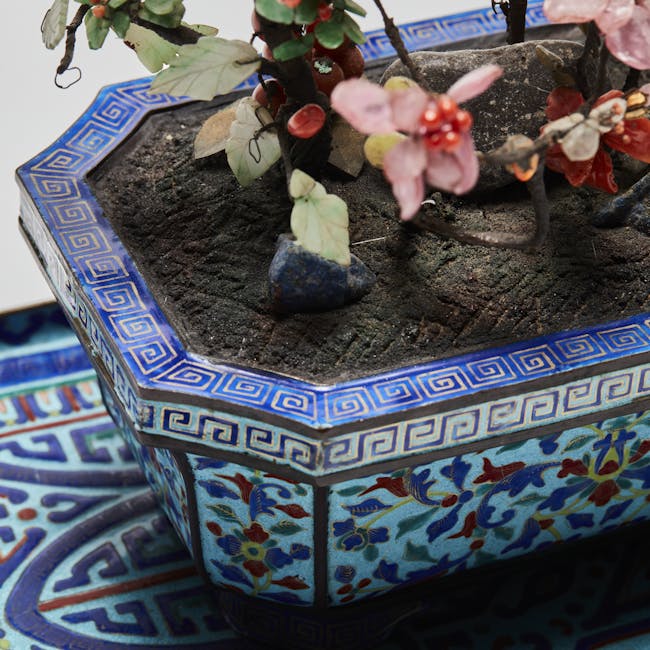An octagonal cloisonné enamel jardinière, decorated all round with flowering branches. The broad edge has a key-fret pattern on the top and side and it stands on bracket feet. It is ‘planted’ with a large and small blossom tree with pale jade leaves and blossoms with bright green petals and coral pistils. The trees grow from a ground laid with three miniature boulders and other flowering shrubs with coral and rose quartz petals. It stands on a rectangular cloisonné tray with archaic motifs.
In China, the art of creating a miniature landscapes in a container, is known as penjing (盆景). The word pen meaning tray or pot and the word jing meaning scenery. These small idealized sceneries, were specifically made for enjoyment and bringing nature indoors. One of the earliest depictions of a penjing, is a mural dating from the Han dynasty (220 BC-220 AD). In the 12th century Buddhist monks took this concept to Japan, where it went on to be known as the Bonsai. The Chinese version differs from its Japanese cousin, in that they are less constrained by rules, focussing on artistic expression and portraying nature, rather than creating perfection.
Potted landscapes, real or fantasy, were highly regarded by the scholarly elite and the Imperial court in the 18th and 19th centuries. Considered to function as equivalents to their outdoors counterpart, penjing provided the literati class with a perfect escape into the natural world - away from the world of mundane affairs. The purpose was not just to re-create nature, but to actually capture its essence. Daoists regard the universe as having a balanced cosmic energy - yin and yang; in small version of nature, this balance was made visual. All aspects of the composition were thought through carefully, including the type of container, the placement and species of the tree, its size, shape and colour. In Daoism, being at one with the environment, was reflected in the desire to surround themselves with nature.
A number of miniature gardens made with semi-precious stones are in the Palace Museum, Beijing. The Asian Civilisations Museum has two potted landscapes with vines (Acc.nr. 1995-03487). The Chinese Pavilion at Drottningholm Castle in Sweden, has marble containers with ivory flowers (HGK 174, 173, 1777:12).






